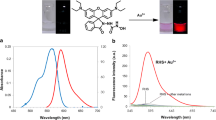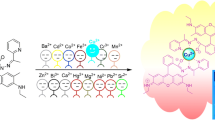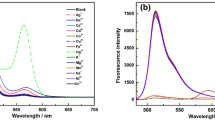Abstract
A new rhodamine-based Schiff base (L) has been synthesized and characterized by physicochemical and spectroscopic tools. This organic molecule selectively reacts with \(\hbox {Cu}^{2+}\) ions with a remarkably significant optical change, which supports the development of a chemosensor for \(\hbox {Cu}^{2+}\) ions as low as nanomolar level in aqueous medium. On the basis of the experimental work, the ‘turn-on’ colorimetric/fluorimetric spectroscopic change is due to \(\hbox {Cu}^{2+}\) ion-assisted hydrolysis followed by spirolactam ring opening of the probe (L) in 20 mM HEPES buffer [pH 7.4; water/acetonitrile (9:1 v/v)]. The competitive ions do not affect the selectivity and specificity of the probe (L) in the detection of \(\hbox {Cu}^{2+}\) ions. The cell imaging study using fluorescence microscope showed that this non-cytotoxic probe is useful to detect the distribution of \(\hbox {Cu}^{2+}\) ions in AGS cells lines.
Graphical abstract
A new turn-on non-cytotoxic rhodamine hydrazone derivative (L) senses \(\hbox {Cu}^{2+}\) ion in nano molar region selectively in 20 mM HEPES buffer [pH 7.4; water/acetonitrile (9:1 v/v)] and is an efficient biomarker to detect \(\hbox {Cu}^{2+}\) ions in living cells.










Similar content being viewed by others
References
Jung H S, Kwon P S, Lee J W, Kim J-II, Hong C S, Kim J W, Yan S, Lee J Y, Lee J H, Joo T and Kim J S 2009 Coumarin-derived \(\text{ Cu }^{2+}\)-selective fluorescence sensor: Synthesis, mechanisms, and applications in living cells J. Am. Chem. Soc. 131 2008
Linder M C and Azam M H 1996 Copper biochemistry and molecular biology Am. J. Clin. Nutr. 63 797S
Uauy R, Olivares M and Gonzalez M 1998 Essentiality of copper in humans Am. J. Clin. Nutr. 67 952S
Gaggelli E, Kozlowski H, Valensin D and Valensin G 2006 Copper homeostasis and neurodegenerative disorders (Alzheimer’s, Prion, and Parkinson’s diseases and amyotrophic lateral sclerosis) Chem. Rev. 106 1995
Zhou Y, Wang F, Kim Y, Kim S-J and Yoon J 2009 \(\text{ Cu }^{2+}\)-selective ratiometric and “Off-On” sensor based on the rhodamine derivative bearing pyrene group Org. Lett. 11 4442
Royzen M, Dai Z and Canary J W 2005 Ratiometric displacement approach to Cu(II) sensing by fluorescence J. Am. Chem. Soc. 127 1612
Barnham K J, Masters C L and Bush A I 2004 Neurodegenerative diseases and oxidative stress Nat. Rev. Drug Discovery 3 205
Hahn S H, Tanner M S, Danke D M and Gahl W A 1995 Normal metallothionein synthesis in fibroblasts obtained from children with indian childhood cirrhosis or copper-associated childhood cirrhosis Biochem. Mol. Med. 54 142
Brown D R 2001 Copper and prion disease Brain Res. Bull. 55 165
Waggoner D J, Bartnikas T B and Gitlin J D 1999 The role of copper in neurodegenerative disease Neurobiol. Dis. 6 221
Vulpe C, Levinson B, Whitney S, Packman S and Gitschier J 1993 Isolation of a candidate gene for Menkes disease and evidence that it encodes a copper-transporting ATPase Nat. Genet. 3 7
Sarkar S, Roy S, Sikdar A, Saha R N and Panja S S 2013 A pyrene-based simple but highly selective fluorescence sensor for \(\text{ Cu }^{2+}\) ions via a static excimer mechanism Analyst 138 7119
EPA US (1991) Maximum contaminant level goals and national primary drinking water regulations for lead and copper; final rule, Federal Register 56, 26460
Yang W, Jaramillo D, Gooding J J, Hibbert D B, Zhang R, Willett G D and Fisher K J 2001 Sub-ppt detection limits for copper ions with Gly-Gly-His modified electrodes Chem. Commun. 37 1982
Becker J S, Matusch A, Depboylu C, Dobrowolska J and Zoriy M V 2007 Quantitative imaging of selenium, copper, and zinc in thin sections of biological tissues (Slugs-Genus Arion) measured by laser ablation inductively coupled plasma mass spectrometry Anal. Chem. 79 6074
Becker J S, Zoriy M, Matusch A, Wu B, Salber D, Palm C and Becker J S 2010 Bioimaging of metals by laser ablation inductively coupled plasma mass spectrometry (LA-ICP-MS) Mass Spectrom. Rev. 29 156
Ensafi A A, Khayamian T, Benvidi A and Mirmomtaz E 2006 Simultaneous determination of copper, lead and cadmium by cathodic adsorptive stripping voltammetry using artificial neural network Anal. Chim. Acta 561 225
Zheng Y, Huo Q, Kele P, Andreopoulos F M, Pham S M and Leblanc R M 2001 A new fluorescent chemosensor for copper ions based on tripeptide glycyl-histidyl-lysine (GHK) Org. Lett. 3 3277
Lai C Y, Trewyn B G, Jeftinija D M, Jeftinija K, Xu S, Jeftinija S and Lin V S Y 2003 A mesoporous silica nanosphere-based carrier system with chemically removable CdS nanoparticle caps for stimuli-responsive controlled release of neurotransmitters and drug molecules J. Am. Chem. Soc. 125 4451
Shao N, Zhang Y, Cheung S, Yang R, Chan W, Mo T, Li K and Liu F 2005 Copper ion-selective fluorescent sensor based on the inner filter effect using a spiropyran derivative Anal. Chem. 77 7294
Lim M H, Wong B A, Pitcock W H, Mokshagundam D, Baik M-H and Lippard S J 2006 Direct nitric oxide detection in aqueous solution by copper(II) fluorescein complexes J. Am. Chem. Soc. 128 14364
Mondal B, Lohar S, Pal S, Maji A and Chattopadhyay P 2015 A new chemosensor selective for \(\text{ Cu }^{2+}\) ions through fluorescence quenching approach applicable to real samples J. Indian Chem. Soc. 92 1867
Mohammad R G, Tahereh P, Leila H B, Shohre R, Mohammad Y, Maryam R K, Abolghasem M, Hossein A and Mojtaba S 2001 Highly selective and sensitive copper(II) membrane coated graphite electrode based on a recently synthesized Schiff’s base Anal. Chim. Acta 440 81
Klein G, Kaufmann D, Schürch S and Reymond J-L 2001 A fluorescent metal sensor based on macrocyclic chelation Chem. Commun. 37 561
Gatta’s-Asfura K M and Leblanc R M 2003 Peptide-coated CdS quantum dots for the optical detection of copper(II) and silver(I) Chem. Commun. 39 2684
Rurack K, Kollmannsberger M, Genger U R and Daub J 2000 A selective and sensitive fluoroionophore for \(\text{ Hg }^{{{\rm II}}}\), \(\text{ Ag }^{{{\rm I}}}\), and \(\text{ Cu }^{{{\rm II}}}\) with virtually decoupled fluorophore and receptor units J. Am. Chem. Soc. 122 968
He G, Zhao X, Zhang X, Fan H, Wu S, Li H, He C and Duan C 2010 A turn-on PET fluorescence sensor for imaging \(\text{ Cu }^{2+}\) in living cells New J. Chem. 34 1055
Zhao H, Wang Y, Liu Z and Dai B 2014 Specific Cu(II) detection using a novel tricarbazolyl-tristriazolotriazine based on photoinduced charge transfer RSC Adv. 4 13161
Pal S, Sen B, Mukherjee M, Dhara K, Zangrando E, Mandal S K, Khuda-Bukhsh A R and Chattopadhyay P 2014 Effect of substituents on FRET in rhodamine based chemosensors selective for \(\text{ Hg }^{2+}\) ions Analyst 139 1628
Xu Z, Xiao Y, Qian X, Cui J and Cui D 2005 Ratiometric and selective fluorescent sensor for \(\text{ Cu }^{{{\rm II}}}\) based on internal charge transfer (ICT) Org. Lett. 7 889
Sen B, Mukherjee M, Banerjee S, Pal S and Chattopadhyay P 2015 A rhodamine-based ‘turn-on’ \(\text{ Al }^{3+}\) ion-selective reporter and the resultant complex as a secondary sensor for \(\text{ F }^{-}\) ion are applicable to living cell staining Dalton Trans. 44 8708
Dessingiou J, Khedkar J K and Rao C P 2014 Chemosensing ability of hydroxynaphthylidene derivatives of hydrazine towards \(\text{ Cu }^{2+}\): Experimental and computational studies J. Chem. Sci. 126 1135
Gunupuru R, Maity D, Bhadu G R, Chakraborty A, Srivastava D N and Paul P 2014 Colorimetric detection of \(\text{ Cu }^{2+}\) and \(\text{ Pb }^{2+}\) ions using calix[4]arene functionalized gold nanoparticles J. Chem. Sci. 126 627
Reddy U G, Ali F, Taye N, Chattopadhyay S and Das A 2015 A new turn on \(Pd^{2+}\)-specific fluorescence probe and its use as an imaging reagent for cellular uptake in Hct116 cells Chem. Commun. 51 3649
Ali F, Saha S, Maity A, Taye N, Si M K, Suresh E, Ganguly B, Chattopadhyay S and Das A 2015 Specific Reagent for Cr(III): Imaging cellular uptake of Cr(III) in Hct116 cells and theoretical rationalization J. Phys. Chem. B 119 13018
Mahato P, Saha S, Das P, Agarwalla H and Das A 2014 An overview of the recent developments on \(\text{ Hg }^{2+}\) recognition RSC Adv. 4 36140
Praveen L, Saha S, Jewrajka S K and Das A 2013 Self-assembly of modified rhodamine-6G with tri-block copolymer: unusual vesicle formation, pH sensing and dye release properties J. Mater. Chem. B 1 1150
Mahato P, Saha S, Suresh E, Liddo R D, Parnigotto P P, Conconi M T, Kesharwani M K, Ganguly B and Das A 2012 Ratiometric detection of \(\text{ Cr }^{3+}\) and \(\text{ Hg }^{2+}\) by a naphthalimide-rhodamine based fluorescent probe Inorg. Chem. 51 1769
Suresh M, Ghosh A and Das A 2008 A simple chemosensor for \(\text{ Hg }^{2+}\) and \(\text{ Cu }^{2+}\) that works as a molecular keypad lock Chem. Commun. 3906
Dujols V, Ford F and Czarnik A W 1997 A long-wavelength fluorescent chemodosimeter selective for Cu(II) ion in water J. Am. Chem. Soc. 119 7386
McClintock J L and Ceresa B P 2010 Transforming growth factor-\(\alpha \) enhances corneal epithelial cell migration by promoting EGFR recycling Invest. Opthalmol. Vis. Sci. 51 3455
Banerjee S, Dixit A, Shridharan R N, Karande A A and Chakravarty A R 2014 Endoplasmic reticulum targeted chemotherapeutics: the remarkable photo-cytotoxicity of an oxovanadium(IV) vitamin-B6 complex in visible light Chem. Commun. 50 5590
Wang S, Wang Z, Yin Y, Luo J and Kong L 2017 Coumarin-naphthol conjugated Schiff base as a “turn-on” fluorescent probe for \(\text{ Cu }^{2+}\) via selective hydrolysis of imine and its application in live cell imaging J. Photochem. Photobiol. A Chem. 333 213
Sahana S, Mishra G, Sivakumar S and Bharadwaj P K 2017 Highly sensitive and selective “turn-on” chemodosimeter based on \(\text{ Cu }^{2+}\) - promoted hydrolysis for nanomolar detection of \(\text{ Cu }^{2+}\) and its application in confocal cell imaging J. Photochem. Photobiol. A Chem. 334 47
Wang L, Yan J, Qin W, Liu W and Wang R 2012 A new rhodamine-based single molecule multianalyte (\(\text{ Cu }^{2+}\), \(\text{ Hg }^{2+}\)) sensor and its application in the biological system Dyes Pigm. 92 1083
Pal S, Lohar S, Mukherjee M, Chattopadhyay P and Dhara K 2016 A fluorescent probe for the selective detection of creatinine in aqueous buffer applicable to human blood serum Chem. Commun. 52 13706
Acknowledgements
The financial assistance from Department of Science and Technology, Govt. of West Bengal (DST, GoWB, vide Project No. 698 (Sanc.)/ST/P/S & T/15-G/2015) is gratefully acknowledged. S. Lohar is thankful to UGC, New Delhi, India for a fellowship. The authors are indebted to Dr. Abhishek Mukherjee, Indian Institute of Chemical Biology, Kolkata for cell imaging and cell viability study.
Author information
Authors and Affiliations
Corresponding author
Electronic supplementary material
Below is the link to the electronic supplementary material.
Rights and permissions
About this article
Cite this article
Maji, A., Lohar, S., Pal, S. et al. A new rhodamine based ‘turn-on’ \(\hbox {Cu}^{2+}\) ion selective chemosensor in aqueous system applicable in bioimaging. J Chem Sci 129, 1423–1430 (2017). https://doi.org/10.1007/s12039-017-1349-4
Received:
Revised:
Accepted:
Published:
Issue Date:
DOI: https://doi.org/10.1007/s12039-017-1349-4




